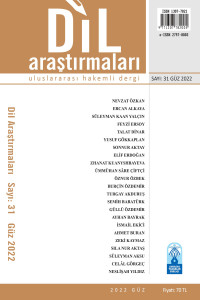Öz
Sesin yazıya aktarımı için kullanılan alfabeler uzun uğraşlar neticesinde kabul görmüş sistematik bir düzen barındıran yapılardır. Alfabeler gelişim süreçleri boyunca kısmen değişimlere uğramakla birlikte kullanım yaygınlığı ile paralel olarak donuk, değişime kapalı yapılar hâlini alırlar. Bu yapıların farklı milletler tarafından benimsenmesi durumunda çeşitli sorunlar ortaya çıkabilir. Bunlardan ilki farklı bir medeniyetin alfabesini benimseyen milletlerin kendi seslerini tam olarak yazıya aktarıp aktaramama meselesidir. Türkler arasında en uzun süre kullanılan Arap alfabesi sıklıkla Türkçenin seslerini tam olarak yansıtamadığı gerekçesiyle eleştirilir. Bununla birlikte Arap alfabesi kullanımıyla süreç içerisinde oluşturulan kalıplaşmış imla geleneği de dönemin telaffuzunu yansıt(a)maz. Bundan dolayı Arap harfli metinlerde zaman zaman müellif ve müstensihlerin kalıplaşmış imla gelenekleri dışına çıkma girişimlerine şahit oluruz. Aynı harfi çift hareke ile işaretleme bizce bu girişimlerden biridir. Bu makalede Türkçe yazılmış Arap harfli metinlerde çift hareke kullanımlarına dikkat çekmeye çalışılmıştır.
Anahtar Kelimeler
Kaynakça
- DEVELİ, Hayati (2012). Osmanlı Türkçesi Kılavuzu 1. İstanbul: Kesit. DOĞAN, Enfel (2011). Şeyhoğlu Sadrüddin’in Kabus-nâme Tercümesi. İstanbul: Mavi. DUMAN, Musa (1995). Evliya Çelebi Seyahatnamesine Göre 17. Yüzyılda Ses Değişmeleri. Ankara: Türk Dil Kurumu. DUMAN, Musa (2000), Birgili Muhammed Efendi Vasiyyet-name. İstanbul: R. ERGİN, Muharrem (2000). Osmanlıca Dersleri. İstanbul: Boğaziçi. ERKAN, Mustafa (1986). Sîretü’n-Nebî (İnceleme-Metin). Doktora Tezi. Ankara: Ankara Üniversitesi. ERKAN, Mustafa (1979). Yüz Hadis ve Yüz Hikaye. Yüksek Lisans Tezi. Ankara: Ankara Üniversitesi. GÜNAYDIN, Alper (2020). “Harekeli Bir Mi‘râciyenin Dîbâcesi ve Osmanlı Türkçesinin İmlası ve Telaffuzu Hakkında Düşündürdükleri”. Türk Dünyası Dil ve Edebiyat Dergisi, 49: 161-183. KABLENDER, Nesibe (2015) “Ferîdüddîn-i Attâr’ın Tezkiretü’l-Evliyâ’sının Türkçe Tercümeleri ve Mütercimleri”. Uluslararası Sosyal Araştırmalar Dergisi, 41: 197-203.
Öz
The alphabets used for the transfer of sound to writing are structures that have a systematic order accepted as a result of long efforts. Although alphabets undergo some changes during their development process, in parallel with the prevalence of use, they become dull, unchangeable structures. Various problems may arise if the alphabet of a nation is adopted by different nations. The first of these is the issue of whether nations adopting the alphabet of a different civilization can translate their own voices into writing. The Arabic alphabet, which has been used for the longest time among the Turks, is often criticized for not being able to translate the sounds of Turkish into writing. However, the stereotyped orthography tradition created in the process with the use of the Arabic alphabet does not reflect the pronunciation of the period. For this reason, from time to time, we witness the attempts of the authors and copyists to go beyond the stereotyped orthographic traditions in the texts with Arabic letters. In our opinion, marking the same letter with a double vowel point is one of these attempts. In this article, it has been tried to draw attention to the use of double vowel point in texts written in Turkish with Arabic letters.
Anahtar Kelimeler
Kaynakça
- DEVELİ, Hayati (2012). Osmanlı Türkçesi Kılavuzu 1. İstanbul: Kesit. DOĞAN, Enfel (2011). Şeyhoğlu Sadrüddin’in Kabus-nâme Tercümesi. İstanbul: Mavi. DUMAN, Musa (1995). Evliya Çelebi Seyahatnamesine Göre 17. Yüzyılda Ses Değişmeleri. Ankara: Türk Dil Kurumu. DUMAN, Musa (2000), Birgili Muhammed Efendi Vasiyyet-name. İstanbul: R. ERGİN, Muharrem (2000). Osmanlıca Dersleri. İstanbul: Boğaziçi. ERKAN, Mustafa (1986). Sîretü’n-Nebî (İnceleme-Metin). Doktora Tezi. Ankara: Ankara Üniversitesi. ERKAN, Mustafa (1979). Yüz Hadis ve Yüz Hikaye. Yüksek Lisans Tezi. Ankara: Ankara Üniversitesi. GÜNAYDIN, Alper (2020). “Harekeli Bir Mi‘râciyenin Dîbâcesi ve Osmanlı Türkçesinin İmlası ve Telaffuzu Hakkında Düşündürdükleri”. Türk Dünyası Dil ve Edebiyat Dergisi, 49: 161-183. KABLENDER, Nesibe (2015) “Ferîdüddîn-i Attâr’ın Tezkiretü’l-Evliyâ’sının Türkçe Tercümeleri ve Mütercimleri”. Uluslararası Sosyal Araştırmalar Dergisi, 41: 197-203.
Ayrıntılar
| Birincil Dil | Türkçe |
|---|---|
| Konular | Dil Çalışmaları |
| Bölüm | Makaleler |
| Yazarlar | |
| Yayımlanma Tarihi | 30 Kasım 2022 |
| Yayımlandığı Sayı | Yıl 2022 Cilt: 16 Sayı: 31 |


